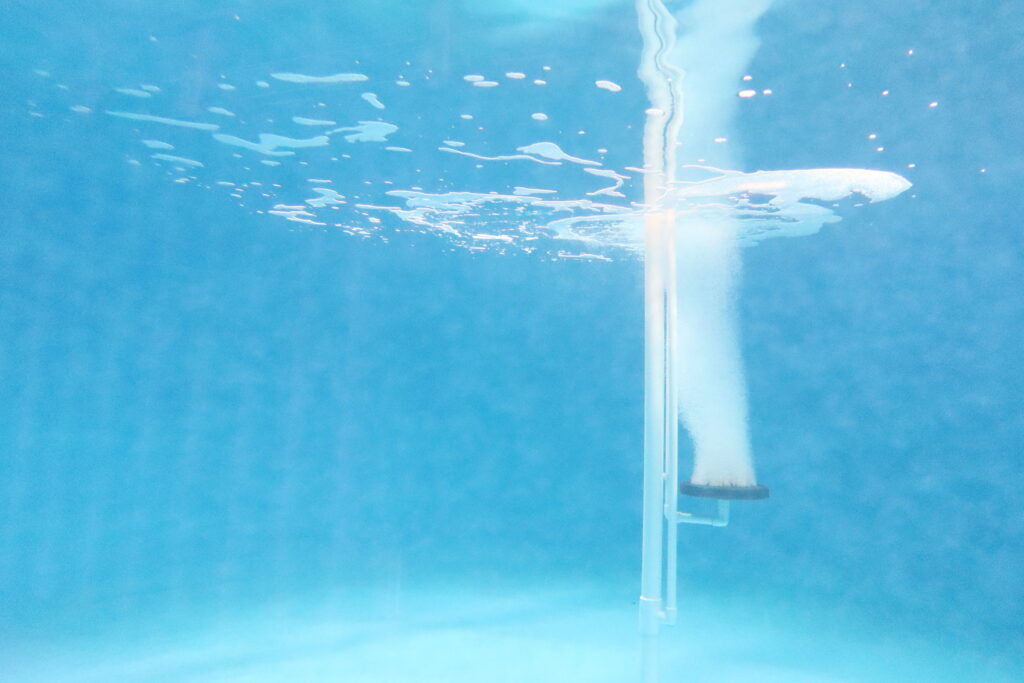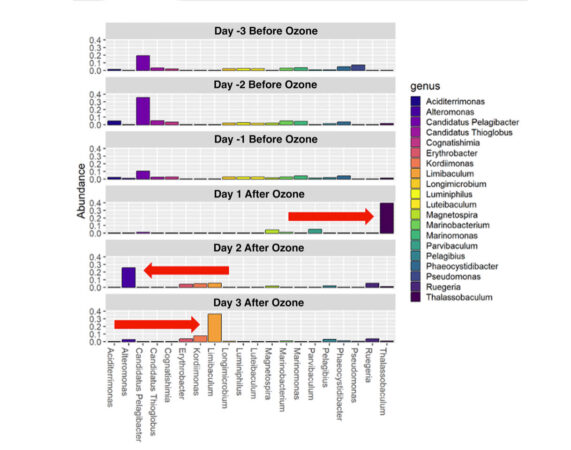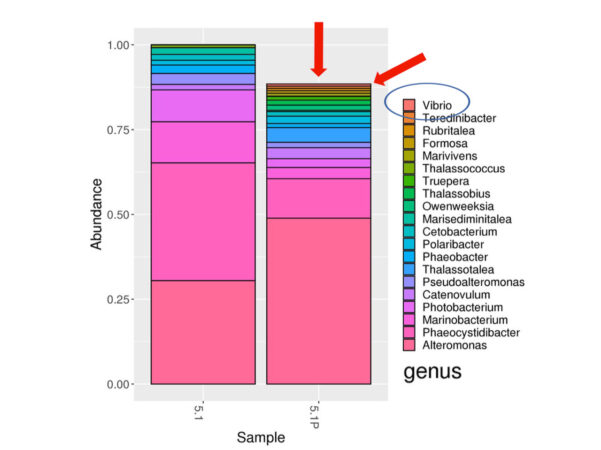
Features
Systems
The unintended cost of water disinfection in RAS
February 3, 2023 By Rachelle Jensen, Luminis Water Technologies
 (Photo: Jean Ko Din, RAStech Magazine)
(Photo: Jean Ko Din, RAStech Magazine) Disinfection is a standard water treatment that reduces the pathogen load before grow-out begins. Effective treatment options include UV, ozone and chlorine. They all work by degrading DNA non-selectively, which means the treatment kills off both good and bad microbes. Ozone, in particular, is very powerful.
Beneficial microbes that deliver essential services for water quality, like ammonia and nitrite reduction, are reduced or eliminated during disinfection. Probiotics are also degraded, which means losing huge benefits like immune support, stress relief, higher growth rates, and lower mortality in stock.
However, the most devastating aspect of water disinfection is the drastic reduction of the diversity and abundance of the overall microbial community, which forms the foundation of health in the aquatic setting.
Once the microbiome destabilizes, we lose the competitive pressure of other microbes that keep pathogens in check. And without any competition for space or resources, survivor pathogens are free to wreak havoc in a system, which they do.
Setting the stage for trouble ahead
There is an inherent balance between removing pathogens and preserving beneficial microbes that are required to support fish and shrimp during growout. To determine ozone’s effect on water and to optimize the use of ozone, we looked at how the microbiome fares after a 12-hour ozone treatment. (Figure 1)

Three days before ozone and three days after ozone. Before ozone application, the microbiome was stable and well balanced. After ozone, crashes in key species introduced deep instability and disruption that leads to increased risk of disease during growout. (Image: Luminis Water Technologies)
We took six samples overall; three consecutive days before the ozone treatment and three consecutive days after ozone. The three samples taken at days -3, -2, and -1 before ozone showed a solid baseline in the water as nature intended it: diverse and stable.
Even at the genus level, we can see that the community changes very little, with only a small drop in the population of Pseudomonas (a good thing), and Candidatus Pelagibacter shifts a bit, but overall we would label this kind of movement as statistically irrelevant.
The three samples taken consecutive days after the ozone treatment shows a very different story. After the ozone application, we see dramatic shifts in the community due to the crash out of almost all the microbial species. At this point, there is a race for equilibrium to fill the newly created void. Over the next three days, we see wild swings in the rise and crash of various species, which shows that the water had not yet reached equilibrium by the end of our study.
A recipe for disaster
If pathogens survived this type of extinction event (which they do), they now face very favourable conditions: very little competition for resources, very little downward pressure from other microbes to prevent outbreaks, and no buffering forces from probiotics or algae to outcompete them. This is the worst place to start grow out.
Day One post-ozone is when the microbiome is severely compromised. Water in this state cannot support high productivity or survivability rates. In fact, we’ve seen tanks promptly crash with a 100% mortality after adding water freshly treated with ozone.
Some operations add probiotics and seeding products to the water at points during grow-out, which is a very prudent thing to do, but our research shows that adding positive counter-forces at this stage is far too late.
To counter balance the destabilization of the microbiome, disinfection protocols should be optimised for both pathogen load reduction and the subsequent rehabilitation of the water before grow-out starts, especially in RAS systems.
Pathogen hitchhikers
In an ideal outcome, all pathogens were killed off during the disinfection protocol, so the only challenge a farmer faces is establishing the water with an effective re-seeding protocol. Effective being the keyword. But many pathogens, especially Vibrio, are unwelcome hitchhikers that are accidentally introduced with newly imported stock.
We looked at what happens to the microbiome when infected stock was added to pathogen-free water. (Figure 2)

The introduction of stock infected with Vibrio harveyi into healthy water had a significant affect on the microbiome, which lost both biodiversity and abundance, key factors that increase risk. (Image: Luminis Water Technologies)
The microbiome in the tank water (Sample 5.1) was stable leading up to the transfer of stock and showed good biodiversity. Biodiversity is a crucial driver of healthy water systems, and diversity means the tank or pond water is more resilient to changes and less prone to future disease events.
The day after infected stock was added (Sample 5.1P), we can see two significant changes: the diversity dropped by almost 25 per cent, and Vibrio became established in the tank.
The presence of Vibrio alone does not necessarily mean that a pathogen outbreak is guaranteed. Pathogens can be successfully managed with the right protocols in place. We consider the road to a full-blown pathogen event to be lined with a number of risks factors. The higher number of the risk factors, the higher the chance of a disease outbreak. In this case, the risk that this tank will experience a disease event is higher, but half the battle is won with awareness of the situation, followed by effective management that can bring the pathogen loads back down again to a low level.
Laying the foundation for high productivity
Water holds the keys to high productivity, specifically the microbes that live in it. Together, they have the power to deliver high survival rates, booming growth, and a very healthy bottom line. If neglected, or unintentionally eliminated, all the benefits they deliver will be drastically reduced, along with profit margins.
Disinfection is Ground Zero for establishing a pattern for success or failure for grow-out. Similarly, water used for water exchange should also be rehabilitated and prepped for grow-out.
Optimizing disinfection protocols with particular attention paid to how inputs and treatments affect the microbiome are a prudent step to take in the successful management of water, especially in RAS systems.
 Rachelle Jensen is CEO of Luminis Water Technologies, a water tech company that provides Next Gen microbiome profiling for the aquaculture industry along with Water Intelligence Reports that cover six critical areas of water health: pathogens, probiotics, biofilter bacteria, biodiversity, and algae/cyanobacteria. Luminis is dedicated to solving the most pressing problems in aquaculture so they can help underpin food security, sustainability, and ease pressure on wild fisheries and the oceans.
Rachelle Jensen is CEO of Luminis Water Technologies, a water tech company that provides Next Gen microbiome profiling for the aquaculture industry along with Water Intelligence Reports that cover six critical areas of water health: pathogens, probiotics, biofilter bacteria, biodiversity, and algae/cyanobacteria. Luminis is dedicated to solving the most pressing problems in aquaculture so they can help underpin food security, sustainability, and ease pressure on wild fisheries and the oceans.
Print this page